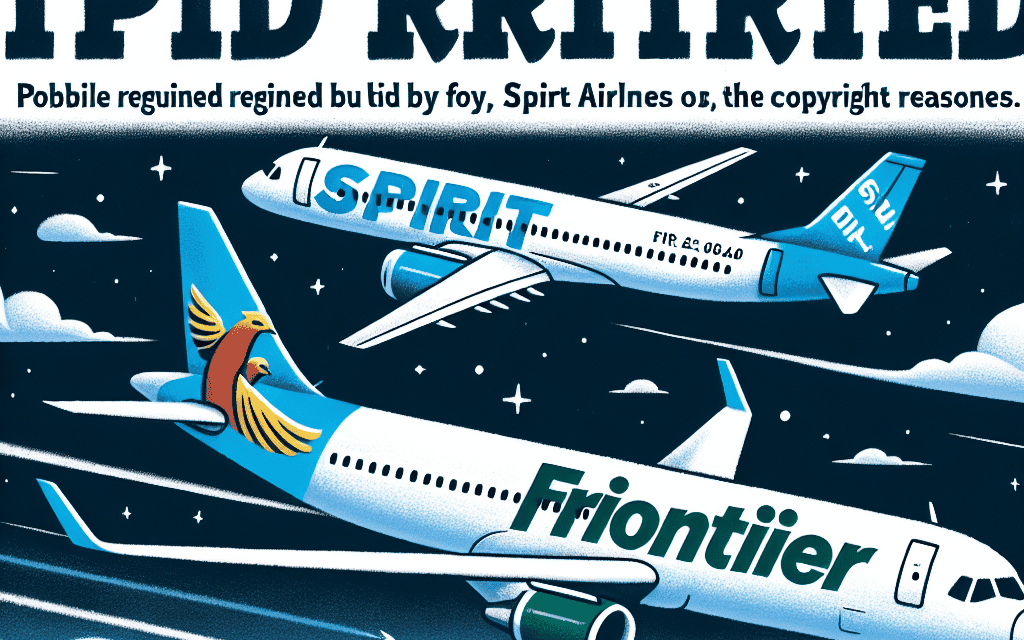“Frontier Eyes the Skies Again: Renewed Bid for Spirit Airlines Takes Flight”
Introduction
Frontier Airlines is reportedly contemplating a renewed bid to acquire Spirit Airlines, according to a report by The Wall Street Journal. This development comes after a previous attempt to merge the two low-cost carriers fell through, paving the way for JetBlue Airways to pursue its own acquisition of Spirit. The potential revival of Frontier’s interest in Spirit signals ongoing consolidation efforts within the airline industry, as carriers seek to expand their market presence and enhance competitive positioning. The renewed bid, if materialized, could reshape the landscape of budget air travel in the United States, offering passengers more options and potentially driving down costs.
Analysis Of Frontier’s Strategic Interest In Spirit Airlines
Frontier Airlines’ renewed interest in acquiring Spirit Airlines, as reported by the Wall Street Journal, marks a significant development in the competitive landscape of the U.S. airline industry. This potential bid comes after a previous attempt to merge with Spirit was thwarted by JetBlue Airways, which ultimately succeeded in acquiring Spirit. Frontier’s strategic interest in Spirit Airlines can be analyzed through several lenses, including market expansion, cost synergies, and competitive positioning.
To begin with, Frontier’s interest in Spirit Airlines is likely driven by the potential for market expansion. Both airlines operate under the ultra-low-cost carrier (ULCC) model, which focuses on providing basic air travel services at the lowest possible cost. By acquiring Spirit, Frontier would significantly increase its market share in the ULCC segment, allowing it to serve a broader customer base across the United States. This expansion would not only enhance Frontier’s domestic presence but also provide opportunities to explore new international routes, leveraging Spirit’s existing network in the Caribbean and Latin America.
Moreover, the merger could result in substantial cost synergies, a critical factor in the highly competitive airline industry. Both Frontier and Spirit have similar business models, which could facilitate the integration process and lead to significant operational efficiencies. By combining their resources, the merged entity could achieve economies of scale, reducing costs related to aircraft maintenance, fuel procurement, and airport operations. These cost savings could be passed on to consumers in the form of lower fares, further strengthening the competitive position of the combined airline.
In addition to cost synergies, a merger with Spirit Airlines would enhance Frontier’s competitive positioning against larger carriers. The U.S. airline industry is dominated by a few major players, such as American Airlines, Delta Air Lines, and United Airlines, which control a significant portion of the market. By acquiring Spirit, Frontier would become a more formidable competitor, with an expanded route network and increased bargaining power with suppliers and airports. This enhanced competitive position could enable Frontier to better withstand economic downturns and fluctuations in fuel prices, which are common challenges in the airline industry.
Furthermore, the potential merger aligns with Frontier’s long-term strategic goals. The airline has consistently focused on expanding its footprint and increasing its market share in the ULCC segment. Acquiring Spirit would be a natural progression of this strategy, allowing Frontier to accelerate its growth trajectory and solidify its position as a leading ULCC in the United States. Additionally, the merger could provide Frontier with access to Spirit’s customer base and loyalty program, further enhancing its ability to attract and retain passengers.
However, it is important to consider the potential challenges and regulatory hurdles that could arise from such a merger. The airline industry is subject to stringent antitrust regulations, and any proposed merger would likely face scrutiny from regulatory authorities. Concerns about reduced competition and potential fare increases could pose significant obstacles to the successful completion of the deal. Therefore, Frontier would need to carefully navigate these regulatory challenges and demonstrate the benefits of the merger to both consumers and regulators.
In conclusion, Frontier Airlines’ renewed interest in Spirit Airlines represents a strategic move to enhance its market position, achieve cost synergies, and expand its route network. While the potential merger offers numerous benefits, it also presents challenges that must be addressed to ensure its successful execution. As the situation unfolds, it will be crucial for Frontier to effectively communicate the advantages of the merger and work collaboratively with regulatory authorities to address any concerns.
Potential Impacts On The Airline Industry From A Frontier-Spirit Merger
The potential merger between Frontier Airlines and Spirit Airlines, as reported by the Wall Street Journal, could significantly reshape the landscape of the airline industry. This renewed bid comes after a previous attempt to merge the two low-cost carriers was thwarted by JetBlue’s successful acquisition of Spirit. As Frontier considers this strategic move once again, it is essential to examine the potential impacts such a merger could have on the airline industry, particularly in terms of competition, consumer choice, and market dynamics.
To begin with, a merger between Frontier and Spirit would create a formidable low-cost carrier, potentially challenging the dominance of major airlines in the United States. By combining their resources, networks, and operational efficiencies, the merged entity could offer more competitive pricing and expanded route options. This could lead to increased pressure on larger airlines to lower their fares, thereby benefiting consumers who are always on the lookout for affordable travel options. Moreover, the merger could stimulate competition in underserved markets, where the presence of a strong low-cost carrier might encourage other airlines to enhance their service offerings.
Furthermore, the merger could lead to significant operational synergies, allowing the combined airline to optimize its fleet utilization and reduce costs. By streamlining operations and eliminating redundancies, the new entity could achieve economies of scale, which would be crucial in maintaining low fares while ensuring profitability. This could also result in improved service quality and reliability, as the airline would have more resources to invest in technology, customer service, and maintenance.
However, it is important to consider the potential challenges and regulatory hurdles that such a merger might face. The airline industry is heavily regulated, and any consolidation is subject to scrutiny by antitrust authorities. Regulators would likely assess whether the merger would reduce competition and harm consumers by creating a monopoly or duopoly in certain markets. To address these concerns, Frontier and Spirit might need to divest certain assets or routes, ensuring that the merger does not stifle competition but rather enhances it.
In addition to regulatory challenges, the merger could face operational integration issues. Merging two airlines with distinct corporate cultures, systems, and processes is a complex task that requires careful planning and execution. Any missteps in this integration process could lead to disruptions in service, negatively impacting customer satisfaction and brand reputation. Therefore, it would be imperative for the management teams of both airlines to work collaboratively to ensure a smooth transition.
Moreover, the merger could have implications for airline employees, as consolidation often leads to workforce restructuring. While the combined airline might create new job opportunities in the long run, there could be short-term job losses as the company seeks to eliminate redundancies and achieve cost efficiencies. It would be crucial for the airline to manage this transition sensitively, providing support and retraining opportunities for affected employees.
In conclusion, the potential merger between Frontier and Spirit Airlines presents both opportunities and challenges for the airline industry. While it could enhance competition, lower fares, and improve service quality, it also faces regulatory scrutiny and operational integration hurdles. As the industry continues to evolve, the outcome of this merger could set a precedent for future consolidations, shaping the competitive dynamics of the airline market for years to come.
Financial Implications Of Frontier’s Renewed Bid For Spirit Airlines
Frontier Airlines is reportedly considering a renewed bid for Spirit Airlines, according to recent reports from the Wall Street Journal. This potential move comes after a previous attempt to merge the two low-cost carriers fell through, primarily due to a competing offer from JetBlue Airways. The financial implications of such a merger are significant, not only for the airlines involved but also for the broader airline industry and its stakeholders.
To begin with, a successful merger between Frontier and Spirit would create a formidable low-cost carrier in the United States, potentially altering the competitive landscape. By combining their resources, the two airlines could achieve greater economies of scale, which might lead to reduced operational costs. This could enable the merged entity to offer even more competitive pricing, thereby attracting a larger customer base. Consequently, this could put pressure on other airlines to adjust their pricing strategies, potentially leading to a more competitive market environment.
Moreover, the merger could result in a more extensive route network, providing passengers with more travel options. By integrating their operations, Frontier and Spirit could optimize their flight schedules and routes, thereby increasing efficiency. This could be particularly beneficial in underserved markets, where the combined airline might be able to offer more frequent service. Additionally, the merger could lead to improved utilization of aircraft and other resources, further enhancing operational efficiency.
However, the financial implications are not solely positive. The merger process itself can be costly and complex, involving significant legal, regulatory, and integration expenses. There is also the risk of potential antitrust scrutiny from regulatory bodies, which could delay or even derail the merger. The airlines would need to demonstrate that the merger would not lead to reduced competition or harm consumers, a task that can be challenging in a highly scrutinized industry.
Furthermore, the integration of two distinct corporate cultures and operational systems can pose significant challenges. Successfully merging the workforces and aligning the corporate strategies of Frontier and Spirit would require careful planning and execution. Failure to do so could result in operational disruptions, employee dissatisfaction, and ultimately, financial losses.
From an investor’s perspective, the merger could present both opportunities and risks. On one hand, the potential for increased market share and improved financial performance could make the merged entity an attractive investment. On the other hand, the uncertainties and challenges associated with the merger process could lead to volatility in the stock prices of both airlines. Investors would need to carefully assess the potential benefits against the risks before making investment decisions.
In conclusion, Frontier’s renewed bid for Spirit Airlines carries significant financial implications for the airlines, their stakeholders, and the broader industry. While the potential for cost savings, increased market share, and enhanced operational efficiency is substantial, the challenges and risks associated with the merger process cannot be overlooked. As the situation develops, it will be crucial for all parties involved to carefully consider these factors to ensure a successful outcome. The potential merger represents a pivotal moment in the airline industry, with the power to reshape the competitive dynamics and influence the future direction of low-cost air travel in the United States.
Regulatory Challenges Facing A Frontier And Spirit Airlines Merger

The potential merger between Frontier Airlines and Spirit Airlines has once again captured the attention of industry analysts and regulatory bodies, as reports from the Wall Street Journal suggest that Frontier is considering a renewed bid for Spirit. This development comes after a previous attempt to merge the two low-cost carriers was thwarted, primarily due to regulatory concerns. As the aviation industry continues to evolve in the post-pandemic era, the prospect of such a merger raises significant questions about the regulatory challenges that could arise.
One of the primary regulatory hurdles facing a potential merger between Frontier and Spirit Airlines is the issue of market competition. The U.S. Department of Justice (DOJ) and the Department of Transportation (DOT) are likely to scrutinize the merger closely to ensure that it does not lead to reduced competition in the airline industry. Both Frontier and Spirit operate as ultra-low-cost carriers, and their merger could potentially create a dominant player in this segment of the market. This could lead to concerns about fare increases and reduced choices for consumers, particularly on routes where the two airlines currently compete.
Moreover, the merger could also face challenges related to antitrust laws. The DOJ has been increasingly vigilant in its efforts to prevent monopolistic practices, and a merger of this magnitude would undoubtedly attract their attention. The agencies would likely conduct a thorough analysis of the potential impact on competition, examining factors such as market share, route overlap, and the potential for new entrants to fill any competitive voids left by the merger. This scrutiny is essential to ensure that the merger does not stifle competition or harm consumers.
In addition to competition concerns, the merger would also need to address operational and logistical challenges. Integrating two airlines with distinct corporate cultures, operational procedures, and fleets is a complex task that requires careful planning and execution. Regulators would likely require detailed plans on how the merged entity would address these challenges to ensure a smooth transition that does not disrupt service or compromise safety standards. Furthermore, labor unions representing employees of both airlines may raise concerns about job security and working conditions, adding another layer of complexity to the regulatory review process.
Environmental considerations are also becoming increasingly important in regulatory assessments of airline mergers. As the aviation industry faces mounting pressure to reduce its carbon footprint, regulators may require commitments from the merged entity to invest in more sustainable practices. This could include measures such as fleet modernization, improved fuel efficiency, and the adoption of alternative fuels. Addressing these environmental concerns would not only be crucial for gaining regulatory approval but also for aligning with broader industry trends towards sustainability.
Finally, the geopolitical landscape could also influence the regulatory review process. With increasing scrutiny on foreign ownership and influence in critical industries, regulators may examine the ownership structures of both airlines to ensure compliance with national security considerations. This aspect, while less prominent than competition and operational concerns, could still play a role in the overall assessment of the merger.
In conclusion, while the renewed bid by Frontier Airlines for Spirit Airlines presents an opportunity to create a formidable player in the low-cost carrier market, it also faces a myriad of regulatory challenges. From competition and antitrust concerns to operational integration and environmental commitments, the path to approval is fraught with complexities. As the process unfolds, it will be crucial for both airlines to engage proactively with regulators, stakeholders, and the public to address these challenges and demonstrate the potential benefits of the merger.
Customer Experience: What A Frontier-Spirit Merger Could Mean For Travelers
The potential merger between Frontier Airlines and Spirit Airlines, as reported by the Wall Street Journal, has reignited discussions about the implications for customer experience in the airline industry. This renewed bid comes after a previous attempt to merge the two low-cost carriers was overshadowed by JetBlue’s successful acquisition of Spirit. As Frontier considers this strategic move, travelers are left to ponder how such a merger could reshape their flying experience.
To begin with, both Frontier and Spirit Airlines have built their reputations on offering budget-friendly travel options, often at the expense of certain amenities. A merger between these two carriers could potentially enhance their ability to provide competitive pricing, as the combined entity would benefit from increased economies of scale. This could lead to lower operational costs, which might be passed on to consumers in the form of reduced fares. For budget-conscious travelers, this prospect is undoubtedly appealing, as it could make air travel more accessible to a broader audience.
However, while cost savings are a significant consideration, the merger could also bring about changes in service quality and customer experience. Both airlines have faced criticism in the past for their no-frills approach, which often includes additional fees for services that other carriers might offer as part of the ticket price. A merger could streamline operations and potentially improve service delivery, but it might also lead to a homogenization of the customer experience, where the distinct characteristics of each airline are lost in the pursuit of efficiency.
Moreover, the merger could impact route availability and network expansion. By combining their resources, Frontier and Spirit might be able to offer a more extensive network of destinations, providing travelers with more options for direct flights and connections. This could be particularly beneficial for passengers in underserved markets, where the presence of a larger, unified carrier might lead to increased flight frequency and improved connectivity. On the other hand, there is a possibility that some overlapping routes could be consolidated, potentially reducing choices for travelers in certain regions.
In addition to route considerations, the merger could influence the frequent flyer programs of both airlines. Currently, each carrier operates its own loyalty program, and a merger would necessitate the integration of these systems. This could present an opportunity to enhance the benefits offered to loyal customers, but it might also lead to changes in how points are earned and redeemed, which could affect the perceived value of these programs.
Furthermore, the merger’s impact on customer service should not be overlooked. Both airlines have faced challenges in this area, and a successful integration would require a concerted effort to address these issues. By pooling their resources and expertise, Frontier and Spirit could potentially improve their customer service operations, leading to a more consistent and satisfactory experience for travelers. However, the complexities involved in merging two distinct corporate cultures could pose challenges that might affect service quality in the short term.
In conclusion, while the potential merger between Frontier and Spirit Airlines presents opportunities for cost savings and network expansion, it also raises questions about service quality and customer experience. As the two carriers explore the possibility of joining forces, travelers will be keenly watching to see how these changes might affect their flying experience. Ultimately, the success of such a merger will depend on the ability of the combined entity to balance operational efficiency with a commitment to enhancing the overall customer journey.
Historical Context: Previous Merger Attempts Between Frontier And Spirit
In the ever-evolving landscape of the airline industry, mergers and acquisitions have long been a strategic tool for companies seeking to expand their market presence and enhance operational efficiencies. The recent report by the Wall Street Journal indicating that Frontier Airlines is considering a renewed bid for Spirit Airlines brings to the forefront a history of previous merger attempts between these two carriers. Understanding the historical context of these attempts provides valuable insights into the motivations and challenges that have characterized their past negotiations.
The relationship between Frontier Airlines and Spirit Airlines has been marked by a series of merger discussions that date back several years. Both airlines, known for their ultra-low-cost business models, have seen potential synergies in combining their operations. The idea of merging has been driven by the prospect of creating a more formidable competitor in the low-cost segment of the airline industry, which is dominated by a few major players. By joining forces, Frontier and Spirit could potentially leverage their combined resources to offer more competitive pricing, expand their route networks, and improve their overall market share.
In previous merger attempts, one of the primary motivations for both airlines was the opportunity to achieve economies of scale. By merging, they could reduce operational redundancies, streamline their fleets, and negotiate better terms with suppliers. This, in turn, could lead to cost savings that would allow them to offer even lower fares to passengers, thereby attracting a larger customer base. Additionally, a merger would enable the combined entity to better withstand economic fluctuations and competitive pressures, which are inherent in the airline industry.
However, despite the apparent benefits, past merger discussions between Frontier and Spirit have faced significant hurdles. Regulatory concerns have been a major obstacle, as antitrust authorities closely scrutinize such deals to ensure they do not lead to reduced competition and higher prices for consumers. The potential for job losses and the impact on employees have also been points of contention, as mergers often result in workforce restructuring. Furthermore, aligning the corporate cultures and operational strategies of two distinct entities presents its own set of challenges, requiring careful negotiation and integration planning.
In addition to these challenges, previous merger attempts have been influenced by the broader economic environment. Fluctuations in fuel prices, changes in consumer travel behavior, and external shocks such as the COVID-19 pandemic have all played a role in shaping the strategic priorities of both airlines. These factors have, at times, led to shifts in focus away from merger discussions as each airline navigated its own path through turbulent market conditions.
As Frontier Airlines reportedly considers a renewed bid for Spirit Airlines, it is essential to recognize that the landscape has evolved since their last merger attempt. The airline industry is gradually recovering from the impacts of the pandemic, and there is a renewed emphasis on operational resilience and adaptability. Both airlines may now find themselves in a position where a merger could offer a strategic advantage in a post-pandemic world, where consumer expectations and competitive dynamics continue to shift.
In conclusion, the historical context of previous merger attempts between Frontier and Spirit Airlines underscores the complexities and potential benefits of such a strategic move. While challenges remain, the evolving market conditions and the lessons learned from past negotiations may pave the way for a more successful outcome should Frontier decide to pursue a renewed bid for Spirit. As the situation unfolds, industry observers will be keenly watching to see how these two carriers navigate the intricate process of potentially joining forces once again.
Competitive Landscape: How A Merger Could Affect Other Low-Cost Carriers
In the ever-evolving landscape of the airline industry, the potential merger between Frontier Airlines and Spirit Airlines has once again captured the attention of industry analysts and stakeholders. According to recent reports from the Wall Street Journal, Frontier is contemplating a renewed bid for Spirit Airlines, a move that could significantly reshape the competitive dynamics among low-cost carriers in the United States. This development comes after a previous attempt to merge the two airlines fell through, leaving many to speculate on the implications such a merger could have on the broader market.
The low-cost carrier segment has been a critical component of the airline industry, offering budget-conscious travelers affordable options and driving competition among airlines. Frontier and Spirit, both known for their no-frills service and competitive pricing, have been key players in this segment. A merger between these two airlines could create a formidable entity with an expanded network, potentially offering more routes and increased flight frequency. This could enhance their ability to compete with larger carriers, such as Southwest Airlines, which has long dominated the low-cost market.
However, the potential merger raises questions about how it might affect other low-cost carriers. For instance, airlines like Allegiant Air and Sun Country Airlines, which have carved out niches by serving underserved markets and offering unique travel experiences, may face increased pressure to differentiate themselves further. The combined resources and operational efficiencies of a merged Frontier-Spirit entity could enable it to offer even lower fares or improved services, compelling competitors to innovate or risk losing market share.
Moreover, the merger could have implications for consumer choice and pricing. While a larger, more robust airline might offer more destinations and potentially lower prices due to economies of scale, there is also the concern that reduced competition could lead to higher prices in the long run. Regulatory bodies would likely scrutinize the merger to ensure it does not harm consumer interests, balancing the benefits of increased efficiency against the risks of reduced competition.
In addition to affecting other low-cost carriers, the merger could also influence the strategies of major airlines. Legacy carriers such as American Airlines, Delta Air Lines, and United Airlines might need to reassess their pricing strategies and service offerings to remain competitive. These airlines have already been adapting to the growing popularity of low-cost carriers by introducing basic economy fares and enhancing their own budget-friendly options. A successful merger could accelerate these trends, prompting further innovation and potentially leading to a more dynamic and competitive market overall.
Furthermore, the merger could have broader implications for the airline industry’s recovery post-pandemic. As travel demand continues to rebound, airlines are seeking ways to capitalize on the resurgence. A merger could position Frontier and Spirit to better capture this demand, leveraging their combined strengths to attract a larger share of travelers. This could, in turn, influence how other airlines approach their recovery strategies, potentially leading to more partnerships, alliances, or even further consolidation within the industry.
In conclusion, the potential merger between Frontier and Spirit Airlines represents a significant development in the competitive landscape of low-cost carriers. While it promises to create a stronger competitor capable of challenging both low-cost and major airlines, it also raises important questions about consumer choice, pricing, and market dynamics. As the situation unfolds, industry stakeholders will be closely monitoring the implications of this potential merger, which could have far-reaching effects on the airline industry as a whole.
Q&A
1. **What is the main topic of the WSJ report?**
Frontier Airlines is considering a renewed bid to acquire Spirit Airlines.
2. **Why is Frontier interested in Spirit Airlines?**
Frontier is interested in Spirit Airlines to expand its market presence and strengthen its position in the low-cost carrier segment.
3. **What happened to the previous bid by Frontier for Spirit Airlines?**
The previous bid by Frontier for Spirit Airlines was unsuccessful, as Spirit ultimately agreed to merge with JetBlue Airways.
4. **What are the potential benefits of a Frontier-Spirit merger?**
A merger could create a larger low-cost carrier, offering more competitive pricing and expanded route options for consumers.
5. **What challenges might Frontier face in renewing its bid for Spirit?**
Frontier might face regulatory scrutiny, competition from other airlines, and the need to offer a compelling proposal to Spirit’s shareholders.
6. **How might Spirit Airlines’ shareholders react to a renewed bid from Frontier?**
Shareholders might be cautious or skeptical, given the previous failed bid and the existing agreement with JetBlue.
7. **What impact could a successful merger have on the airline industry?**
A successful merger could increase competition in the low-cost segment, potentially leading to lower fares and more options for travelers.
Conclusion
Frontier Airlines is reportedly considering a renewed bid for Spirit Airlines, as reported by the Wall Street Journal. This development follows a previous attempt by Frontier to acquire Spirit, which was ultimately unsuccessful due to a competing offer from JetBlue Airways. The renewed interest suggests that Frontier is still keen on expanding its market presence and operational scale through a merger with Spirit. Such a move could potentially reshape the competitive landscape of the U.S. airline industry by creating a larger low-cost carrier capable of challenging major airlines. However, any new bid would likely face scrutiny from regulators concerned about market competition and consumer impact.





